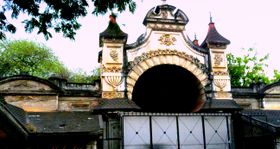King Kothi Palace
| King Kothi Palace | |
|---|---|
 Entrance gate of the King Kothi Palace | |
 Entrance gate of the King Kothi Palace | |
| General information | |
| Status | Owned by the Nizam of Hyderabad |
| Location | Hyderabad, Telangana State, India |
| Opening | 1911 |
| Owner | Nizam of Hyderabad |
| Design and construction | |
| Architect | Kamal Khan |
King Kothi Palace or Nazri Bagh Palace is a royal palace in Hyderabad, Telangana, India. It was the palace where the erstwhile ruler of Hyderabad State, Sir Mir Osman Ali Khan, lived.[1][2]
Etymology[edit]
Initially constructed this palace for his personal residence: Thus, the main gate, passerby corridors, windows and doors were engraved with the sign of "KK". Later when Nizam purchased this palace, the young Nizam felt against his pride to have the abbreviations of other nawabs; he passed a firman and changed the abbreviation "KK" to "King Kothi," meaning king's mansion. Thus the name King Kothi came into existence.[2][3]
History[edit]
The palace was constructed by Kamal Khan, and sold to Nizam once he expressed his desire for the palace. The young Nizam moved in when he was only 13. After his accession to the throne in 1911, he continued to stay at the palace and did not move to Chowmahalla Palace where his father lived.
In the sprawling palace, various kinds of expensive items were stored in steel trunks, fastened with English-made padlocks.[4] The palace has three main buildings, divided into two groups. It also has a huge library used by the last Nizam.[5]
The eastern half, now occupied by a state government hospital, was used by the Nizam for official and ceremonial purposes. The western half, which is now walled, has the main residential buildings known as Nazri Bagh or Mubarak Mansion and still belongs to the Nizam’s private estate.
The main entrance to Nazri Bagh always had a curtain draped across it, so it has come to be known as the purdah gate. When Nizam went out of the palace, the purdah was lifted to indicate the king was not home. The gate was guarded by Maisaram Regiment, police and Sarf-e-Khas Army bearing lances.[6] The Nizam lived here until his death in 1967.[2]
Architecture[edit]
The palace is marked by large arched entrances and columns, intricate woodwork on canopied windows, and a large portico at the entrance.[3]
Present status[edit]
Of the three principal buildings of the King Kothi complex, only the main building (now housing a hospital) and the Mubarak Mansion (Nazri Bagh) accommodating the offices of the Nizam’s private estates (Sarf E Khas) survive. Both the surviving buildings are in European style.[7]
The third building, Usman Mansion, was demolished in the early 1980s. In its place a new hospital building was constructed by the state government. The VII Nizam, Sir Mir Osman Ali Khan, the last ruling Nizam (1911–1948), lived here and died in this building on 24 February 1967.
The palace is also home to the Judi Mosque. Khan willed that he be buried in the mosque that faced his residence.[8]
To the east of Mubarak Mansion stands the Ghadial Gate, the gate with a clock.
The King Kothi complex has various European styles. The canopies over windows, the intricate woodwork, the sloping tiled roofs in octagonal pyramid shapes of the Ghadial Gate complex, and the classical semicircular arches are among the characteristic features.
References[edit]
- ↑ "No takers for Nazri Bagh Palace". The Times of India. Archived from the original on 5 November 2012. Retrieved 7 March 2012.
- ↑ 2.0 2.1 2.2 Bhavani, Divya Kala (31 May 2017). "Fading Palatial Facade". The Hindu. ISSN 0971-751X. Retrieved 6 February 2019.
- ↑ 3.0 3.1 Khalidi, Omar (2009). A Guide to Architecture in Hyderabad, Deccan, India (PDF). p. 163. Archived from the original (PDF) on 25 September 2019. Retrieved 13 March 2020.
- ↑ The treasure at King Kothi Palace
- ↑ "A peek into the royal library". The Times of India. Archived from the original on 18 December 2013. Retrieved 7 March 2012.
- ↑ The King Kothi Palace
- ↑ Present status of the King Kothi Palace Archived 6 July 2013 at the Wayback Machine
- ↑ "Archived copy". Archived from the original on 10 June 2007. Retrieved 19 November 2012.
{{cite web}}: CS1 maint: archived copy as title (link)
External links[edit]

